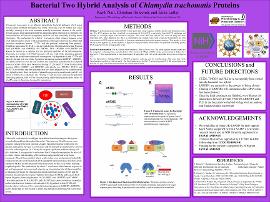| dc.contributor.advisor | Lutter, Erika | |
| dc.contributor.author | Nail, Kayli | |
| dc.contributor.author | Holcomb, Christian | |
| dc.date.accessioned | 2021-09-30T15:37:45Z | |
| dc.date.available | 2021-09-30T15:37:45Z | |
| dc.date.issued | 2021-10-09 | |
| dc.identifier | oksd_OK-LSAMP_2021_nail | |
| dc.identifier.citation | Nail, K., Holcomb, C., & Lutter, E. (2021, October 9). Bacterial two hybrid analysis of Chlamydia trachomatis proteins. Poster presented at the Oklahoma Louis Stokes Alliance for Minority Participation's 27th Annual Research Symposium, Stillwater, OK. | |
| dc.identifier.uri | https://hdl.handle.net/11244/331002 | |
| dc.description.abstract | Chlamydia trachomatis is an obligate intracellular bacterial pathogen which poses severe health problems throughout the world. There are over 90 million new cases annually, making it the most common sexually transmitted disease in the world. Chlamydia can pose significant problems during and after infection. It is imperative to understand how Chlamydia manipulates the host cell and potentially develop future treatments. The mechanisms by which C. trachomatis alters immune response is not well understood, but recent work has identified an interaction between the chlamydial inclusion membrane protein, CT226, and the potential interacting host proteins, Flightless homologue II (FLII), Leucine Rich-Repeat Flightless-Interacting Proteins 1&2 (LRRFIP1 and LRRFIP2) and TMOD3. FLII, LRRFIP1 and LRRFIP2 are known to interact as a complex and are upstream regulators of the inflammasome. Currently, it is unknown if CT226 interacts with one or all of the interacting partners and needs the actual interaction needs investigation. My hypothesis is that CT226 will directly interact with one of the 3 potential interacting partners (LRRFIP1, LRRFIP2, and FLII) and that we will be able to detect this interaction in the bacterial two hybrid system. Current efforts have focused on cloning CT226 into PUT18 and the three host proteins (FLII, LRRFIP1 and LRRFIP2) individually into PKNT25. PUT18 and PKNT25 are the bait and prey plasmids that have been adapted for use in the bacterial two hybrid system. Once each pair of plasmids are properly transformed (each E. coli strain will have two plasmids, one carrying CT226 and one carrying the potential interacting partner), they will be screened using traditional B-galactosidase assays or cAMP assays to determine the specific interactions. | |
| dc.description.sponsorship | Oklahoma Louis Stokes Alliance for Minority Participation Program | |
| dc.description.sponsorship | National Science Foundation (U.S.) | |
| dc.description.sponsorship | National Institutes of Health (U.S.) | |
| dc.description.sponsorship | Lew Wentz Foundation | |
| dc.format | application/pdf | |
| dc.language | en_US | |
| dc.publisher | Oklahoma State University | |
| dc.rights | In the Oklahoma State University Library's institutional repository this paper is made available through the open access principles and the terms of agreement/consent between the author(s) and the publisher. The permission policy on the use, reproduction or distribution of the article falls under fair use for educational, scholarship, and research purposes. Contact Digital Resources and Discovery Services at lib-dls@okstate.edu or 405-744-9161 for further information. | |
| dc.title | Bacterial two hybrid analysis of Chlamydia trachomatis proteins | |
| osu.filename | oksd_OK-LSAMP_2021_nail.pdf | |
| dc.description.department | Microbiology and Molecular Genetics | |
| dc.type.genre | Poster | |
| dc.type.material | Text | |
| dc.subject.keywords | put18c | |
| dc.subject.keywords | ct226 | |
| dc.subject.keywords | lrfip1 | |
| dc.subject.keywords | tmod3 | |
| dc.subject.keywords | fl2 | |
